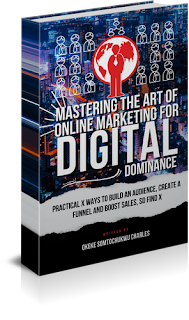 |
| The Book |
Mastering the Art of Online Marketing for Digital Dominance
Practical X ways to build an audience, create a funnel and boost sales, so find X
Watch the YouTube video above
Here's a comprehensive guide or table of contents, to help you achieve digital dominance through online marketing:
1. Understand Your Audience:
2. Set Clear Goals:
3. Develop a Strong Online Presence:
4. Content Marketing:
5. Search Engine Optimization (SEO):
6. Pay-Per-Click (PPC) Advertising:
7. Social Media Marketing:
8. Email Marketing:
9. Influencer Marketing:
10. Analytics and Data Analysis:
11. Mobile Optimization:
12. Conversion Rate Optimization (CRO):
13. Customer Relationship Management (CRM):
14. Compliance and Privacy:
15. Continuous Learning and Adaptation:
Click the link below to get started
The art of online marketing and achieving digital dominance involves a strategic and creative approach to harnessing the power of digital channels to effectively promote your brand, products, or services, and ultimately establish a strong online presence. Here are some key elements and strategies that constitute this art in this book:
1. Strategy and Planning:
- Start with a well-defined digital marketing strategy that aligns with your business goals and target audience.
- Conduct market research to understand your competitors and audience preferences.
2. Brand Storytelling:
- Craft a compelling brand story that resonates with your target audience's emotions and values.
- Use storytelling in your content to create a connection with your audience.
3. Content Creation:
- Create high-quality, engaging content that educates, entertains, or solves problems for your audience.
- Diversify your content formats, including blog posts, videos, infographics, podcasts, and more.
4. Search Engine Optimization (SEO):
- Optimize your website and content for search engines to improve organic visibility.
- Conduct keyword research to target the right search terms.
5. Social Media Mastery:
- Choose the right social media platforms for your business and audience.
- Develop a consistent posting schedule and engage with your followers authentically.
- Utilize social media advertising and paid promotions when necessary.
6. Email Marketing:
- Build and segment your email list for targeted communication.
- Send personalized and relevant emails to nurture leads and retain customers.
7. Data-Driven Decision Making:
- Utilize analytics tools to gather data and insights on your digital marketing efforts.
- Use data to make informed decisions and optimize your strategies for better results.
8. User Experience (UX):
- Ensure your website and digital assets are user-friendly, responsive, and offer a seamless experience.
- Implement A/B testing to optimize user journeys.
9. Innovation and Adaptation:
- Stay updated with emerging digital trends and technologies.
- Be open to innovation and adapt your strategies as the digital landscape evolves.
10. Paid Advertising:
- Run paid advertising campaigns on platforms like Google Ads, Facebook Ads, and Instagram Ads.
- Set clear objectives and target your ads to reach the right audience.
11. Conversion Optimization:
- Continuously improve your website and landing pages to increase conversion rates.
- Implement call-to-action (CTA) strategies to guide users toward desired actions.
12. Community Building:
- Foster an online community around your brand or niche.
- Encourage user-generated content and engage in conversations with your audience.
13. Mobile Optimization:
- Optimize your digital assets for mobile devices, as a significant portion of users access content via smartphones and tablets.
14. Online Reputation Management:
- Monitor your online reputation and respond to customer feedback and reviews promptly.
- Use positive reviews to build trust and credibility.
15. Local SEO (if applicable):
- If your business serves a local audience, optimize for local search to ensure your business appears in local map listings and searches.
16. Ethical Marketing Practices:
- Conduct your digital marketing activities with integrity and transparency, adhering to relevant laws and regulations.
17. Continuous Learning and Growth:
- Invest in ongoing education and skill development for yourself and your team to stay ahead in the digital marketing landscape.
Achieving digital dominance is an ongoing process that requires a combination of creativity, data analysis, and adaptability. The "art" lies in the ability to connect with your audience authentically, tell your brand story effectively, and constantly refine your strategies to meet the changing demands of the digital world.







No comments:
Post a Comment
Thanks you for your concern towards this blog, share your view about this post by clicking on comment. Have a nice day ahead.
Place your Advert for as low as $10 call 08061154825